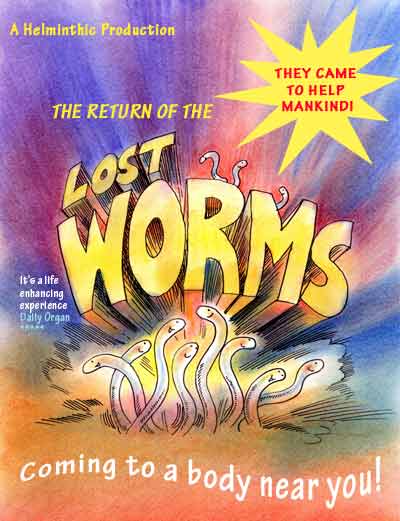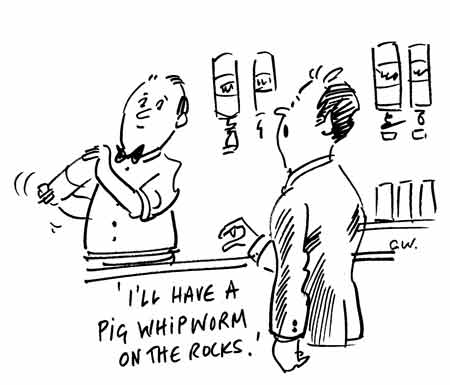|
|
Helminthic Therapy - Replacing lost worms to regain health – John Scott - 2009 |
Helminthic therapy is an experimental approach to the treatment of asthma, allergies and inflammatory and autoimmune diseases, which involves the administration of controlled quantities of selected, benign intestinal parasites such as hookworm and whipworm. Synergistic relationship Ideally, exposure to our 'old friends' should begin during infancy, when the immune system is developing, but some organisms can still bring immune/inflammatory responses back into balance when they are re-introduced later in life. When bacteria from the intestines of healthy donors were transplanted, via enemas, into the colons of six patients with severe chronic ulcerative colitis, patients' symptoms were completely reversed in four months, in spite of ceasing all other medications for the condition, The oral administration of particular strains of probiotic bacteria is gradually becoming an established practice, and research continues to reveal benefits for this form of therapy, but there is a daunting number of different strains of probiotic bacteria to be investigated and this branch of science is still in its infancy. Helminthic therapy, however, offers a simple, convenient and ready-made source of relief for a number of chronic conditions, with success rates, as measured by the number of patients achieving remission, at least equal to and, in many cases, higher than those recorded for immune-modulating and anti-inflammatory drugs. Helminthic selection Two particular helminths which have been, and are still being used in research, and are also available from commercial outlets, are the human hookworm Necator americanus and the pig whipworm Trichuris suis. One supplier is also now offering a third organism - the human whipworm (Trichuris trichiura). All three worms share a number of advantages, namely that none of them causes any disease in man at therapeutic doses, nor is able to reproduce within a host, or pass easily from one person to another. All are compatible with conventional medical treatments and are easily eradicated, if this should be required. Hookworms survive for an average of five years, human whipworms for approximately two years and pig whipworms for 2-3 weeks, the relative longevity of hookworm and human whipworm making them much more cost-effective than the pig whipworm. Inoculation with hookworm is achieved by a single application to the skin of 25-35 microscopic larvae. These are available from Autoimmune Therapies at a cost of $2,900.00. Side effects from inoculation with this number of hookworms are transient, if present at all, and can include a rash at the inoculation site, possibly followed by gastrointestinal symptoms and fatigue in some individuals during the following 1–4 weeks. As hookworm feed on their host's blood, anaemia can develop in individuals who host extremely large numbers of this organism. However, 35 hookworms only take a total of one teaspoonful (5 ml) of blood per month, so the risk of anaemia at this dose is insignificant. Pig whipworm ova (TSO), available from Ovamed, are taken orally in a drink, and patients normally start with four separate doses of 500 ova, taken every one to three weeks. If there is no reduction in symptoms on this regimen, the dose is increased to 1000 ova per dose, up to a maximum of 2500 ova per dose every two weeks, which is the dose most frequently required, at a cost of $400.00 per dose.
There have been occasional reports of allergic reactions to whipworm but, compared with the side effects experienced by patients taking conventional immune-modulating or anti-inflammatory drugs, the side effects of whipworm are negligible. Human whipworm ova (TTO) are similar to TSO but, because they are adapted to humans, they do not die off as quickly as pig whipworms. They are available from Autoimmune Therapies at a cost of $2,900.00 for a dose which will last approximately two years. The evidence suggests that whipworm and hookworm produce similar beneficial results in all conditions except ulcerative colitis, which seems to respond even better to whipworm. It is possible that hosting more than one species of worm at the same time may provide increased benefit, as multiple helminth species appear to promote stronger immunological regulation. However, as yet, there are few individuals hosting more than one type of worm for therapeutic purposes, so feed-back is limited. Combination therapy (hookworm plus human whipworm) is available from Autoimmune Therapies for $3,900.00 The future for helminthic therapy In order for more people to be able to benefit from helminthic therapy, there is an urgent need for a reduction in the cost of commercially produced worms and, ideally, for them to be available in the UK on the NHS. The price of hookworm larvae from Autoimmune Therapies has recently been reduced significantly, and the cost of both larvae and ova will hopefully reduce still further with greater demand, but it is likely to be some time yet before this picks up to any great extent, in view of the generally negative attitude towards worms of both patients and doctors. The treatment is not likely to become widely available on the NHS until sufficient research has been completed for it to lose its experimental status, although reading between the lines of the press release for the latest Nottingham trial, one gets the impression that, if the study was to demonstrate the treatment's effectiveness for MS, the medics involved may then employ this treatment, which is described as simple, natural and controllable, for the wider benefit of MS patients generally. This may then become a precedent for the use of worms in the treatment of other conditions. Who knows where this development may eventually lead? We might perhaps one day see children given their first dose of helminths in infancy, particularly those with the highest risk of developing allergies, and those whose genetic profiles indicate the likely development of autoimmune or inflammatory disease later in life. It is already apparent that helminthic therapy has huge potential to improve the health of millions of people worldwide and to transform the practice of medicine, but, in order to benefit from it, we must first re-embrace the idea of coexistence with those companion organisms which have for so long shared our evolutionary journey and, without which, we are no longer complete. Further information For an explanation of the theoretical framework supporting helminthic therapy - www.hygienehypothesis.com For an explanation of helminthic therapy and a large collection of some very good research papers - www.helminthictherapy.com For an article detailing one patient's experience of the Hookworm in Crohn's Disease trial at Nottingham. For information on the use of helminthic therapy with specific diseases, go to www.ncbi.nlm.nih.gov/pubmed and enter "helminth" plus the name of the disease you're interested in. For the latest research relating to the worms and bugs that keep us well, check out the Gut Buddies blog. For up-to-the-minute discussion on all matters helminthic, visit the Yahoo helminthic therapy forum. Registration required; not moderated. Click on the Files link on the left for dozens of good research papers. For discussion about TSO, visit the Ovamed forum. Registration required; moderated.
|














